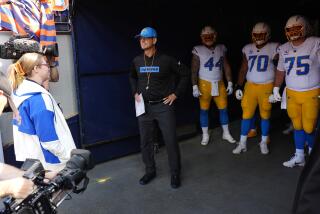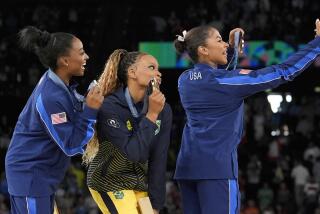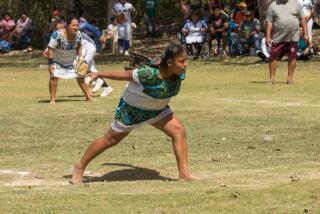Woman Doctor Makes Mark on Football Team
LEXINGTON, Ky. — Bob Thistleton just had to have the cast off his leg if he was going to have any fun in Louisville Friday night.
He sat in the training room of the University of Kentucky Wildcats on a recent afternoon and thought of ways he could persuade the team physician to free him of his burden: He’d promise to be good; maybe he’d offer to take her to dinner. . . .
Dr. Mary Lloyd Ireland had temporarily turned her Orange, Calif., orthopedic practice over to her associates only weeks before. She plunged with little preparation into the life of a Division 1 football team when Dr. James Andrews, a Columbus, Ga., physician who had supervised Ireland in a sports medicine fellowship, asked her to take his place as team physician this season while he serves as consultant.
The 32-year-old Ireland admitted that she was still catching up on football lingo. But already she’d learned the adage of a successful team doctor: Know thy players.
Weekend Rowdiness
It wasn’t that Bob Thistleton was such a hell-raiser, but the defensive end he was driving to Louisville with was a self-described “hard head” who hated to acknowledge his limits whether it was on a football field or on the town.
Ireland had an inkling that Thistleton and friend would get rowdy in Louisville, and that it would be prudent to keep the leg under wraps until they returned. “You come back in here Sunday afternoon and I’ll zip the cast off for you,” she told the patient, who began to protest. Then she patted the player’s knee, which was crisscrossed with bubbly blue scars. (Thistleton has been operated on three times in two seasons and is currently on a medical scholarship, meaning that he no longer plays on the team.)
Ireland sent him on his way by snapping her fingers followed immediately by a clap of her hands. It’s a gesture common to training-room staff and signals something like: end of discussion.
Ireland is the only woman in recent history to serve as team physician for a major men’s team. (There apparently was a woman doctor for the Kent State football team in the ‘40s.) While female orthopedic residents have on occasion rotated through team rooms as part of their training, Ireland is official--she attends practices and home games, plus she travels with the Wildcats.
The consensus of trainers and players early in the season is that she may well be the best team doctor they’ve ever had. “You can relate to her more than you can to an older doctor,” said Dan McMillan, a 22-year-old defensive guard who required knee surgery after being injured in the first game of the season. “I see her sometimes on the sidelines during a game and she’s fired up,” he added, with a tone of respect. “Since I got to know Dr. Ireland, she’s just as cool as she can be.”
Head trainer Al Green said that unlike some team physicians who show up only for the games, Ireland spends two to three unpaid hours a day in the training room.
Attends Games Without Pay
The Saturdays she spends attending games are also without pay. (Ireland is not paid a salary by the university, but makes her income from seeing players who need special attention in her temporary office in Lexington. She is also paid per procedure for surgery performed on athletes.)
In the training room, Ireland moves from athlete to athlete, keeping up a jock-like patter. She never lectures the players in a parental fashion as some doctors might. She comes across like an upbeat fan who wants her team to win, and in fact she has been a Wildcat fan ever since she was a child growing up in Lexington.
“You need to have been around athletes to do this job,” said Green. “You can’t understand their motivation for wanting to come back and play after being hurt unless you’ve been there yourself.”
Ireland was a competitive swimmer for her Lexington high school. (Her parents still live in town.) After attending Memphis State University as an undergraduate, she entered the University of Tennessee Medical School, always making time in her studies to swim. She competed in the World University Games in Moscow in 1973; and she tried out for the Olympic team in 1972 and 1976. She also has played basketball and field hockey.
Battered-Up Athlete
“I was kind of a battered-up athlete myself,” Ireland said, “so I’m comfortable with athletes and can communicate with the trainers fairly well.”
When it came time to settle on a specialty, Ireland considered going into pediatrics, but was ultimately drawn to orthopedics because she saw sports medicine as a field she could have fun with, she said. She did her residency at UC Irvine.
The path was a tough one, not only because orthopedic training is long--it took Ireland six years after she finished medical school--but because women have not been encouraged to go into orthopedics. Ireland said she had a hard time finding anyone who would even tell her it was possible. (The American Medical Assn.’s statistics from 1982, which are the most recent available, showed that out of 15,571 orthopedic specialists in the country, there were only 211 women.)
A Range of Injuries
As hard as football can be on young bodies, it is the ideal game for a young sports medicine practitioner who desires exposure to a range of injuries. “You see things in one week of football that would take you years to observe in a non-contact sport,” said University of Kentucky assistant trainer Sue Stanley, who previously worked with female volleyball and basketball players and swimmers. “Until I worked football I didn’t see the blown-out knees and dislocated shoulders.”
Ireland said that the opportunity to work as a team physician is a way of accelerating her on-the-job experience, so that when she returns to Orange County after football season is over, she’ll be ready for any problem a skateboarder or Sunday tennis player can bring to her.
It’s crucial that the team doctor know the players well enough so that when they go down on the field, she’ll know whether they’re the sort to bluster or to overreact. To this end, Ireland spends hours watching the Wildcats scrimmage out behind the training room. This way she also learns the mechanics of the sport so that she’s able to judge if a player can function in his position with a particular injury.
Ligament Strain
For instance, she fashioned a silicon rubber arm brace to be worn in the game against Cincinnati by a center with a ligament strain. She demonstrated the way the athlete would plant the knuckles of his left hand in the grass while he snapped with his uninjured right hand, and how the brace would allow him to do that.
Although the football players keep her busy (last spring at one time there were 28 players on the injured list), Ireland also advises the university’s other athletes who share the training room. So while a sweat-streaked quarterback is having his leg taped on one table, there might be a female cross-country runner awaiting medical attention just across the room.
The University of Kentucky has the only co-ed training room in the Southeastern Conference; co-ed training arrangements are more common in the West, but, throughout the country, most of the trainers who work with male athletes are also male.
‘Utopia’ in Kentucky
Stanley said that Kentucky is “utopian” in terms of affording women equal status in the sports department. Because the assistant trainer is a woman--as are five of the 17 student trainers--Ireland’s arrival on the scene, though unique on a national level, was not a big deal in Lexington, Stanley said.
“But if she (Ireland) were to show up at Ohio State (Stanley previously worked in the training room at that school, as well as Purdue and East Carolina) or some other schools, it would be a very big issue.”
A woman physician did in fact appear in the training room at Ohio State University last year to work alongside the team doctor on a sports medicine fellowship. Although she was seeing male and female athletes involved in all other sports, Dr. Sandra Eisele said she initially was told she could not tend to the football players.
“I said: ‘Wrong. I’m here to get training with all athletes,’ ” Eisele said in a telephone interview from Knoxville, Tenn., where she is in private practice in orthopedics. Refusing to have her training compromised by the coach’s belief that a woman had no place administering to his team, Eislee appealed to the administration and eventually was allowed to work with football players.
Resorted to Subterfuge
At least one female orthopedic surgeon has resorted to subterfuge in order to get the experience working with football players that she desired. It was 10 years ago at a large Midwestern university. The doctor, who asked not to be named, said that she had arranged to rotate through the team room during her residency, but she knew the coach did not approve of females working with his football players.
So every day after practice, a trainer would go out to the parking lot after the coach had left and fetch the doctor, who was waiting in her red Volkswagen. She’d see her patients and leave again, without the coach ever knowing she had been there.
Kentucky coach Jerry Claiborne, however, said of Ireland: “As long as she knows what she’s doing, that’s all that matters.”
The team doctor is, in a way, like the page who girds the medieval knight for battle. Hardly anyone in the stands knows who she is when she roves the sidelines during a game, but if a player she’s operated on completes a stunning play, she can’t help but feel some of the glory. “You kind of feel like your brothers are out there playing,” Ireland said of the shared-pride sensation.
The thing about warriors, though, is that they return from battle all chewed up, and the pages have to go to work restoring them once more. Ireland’s work in Kentucky is different in that way from her practice back home in Southern California--a football player she’s fixed up is probably not going to stay repaired.
There is an ethical question that a highly trained doctor must ask herself, Ireland admitted: “Do you believe in people going out and crashing up their bodies, or should they be doing something else? I feel it’s the athletes who have to make that decision,” she said. “If that’s what they want to do (bash themselves in the name of sport), then I’ll try to keep them playing.”
‘On Your Side’
The players are convinced that Ireland is behind them in this matter. After Dan McMillan’s recent arthroscopic surgery, the team doctor told him he could be back on the field in as soon as six weeks. “I think sports doctors are definitely on your side,” McMillan observed. “If it was my family physician, he probably wouldn’t want me to play for a year.”
The family doctor back home most likely wouldn’t cheer him on at the pep rally after office hours, either. But following a recent session in the training room, Ireland talked some rather reluctant trainers into accompanying her to a rally the night before the Wildcats met their Cincinnati rivals, the Bearcats.
There was a full moon, and a green laser light making endless loops high up in the stands. Packs of noisy sorority women crowded in shoulder-to-shoulder with Ireland and her training room cohorts, who were reverential as they watched the team march out. These were some of the same young men who’d been taped and bandaged only an hour earlier in the training room. And now they were invincible and ready to fight.
More to Read
Go beyond the scoreboard
Get the latest on L.A.'s teams in the daily Sports Report newsletter.
You may occasionally receive promotional content from the Los Angeles Times.










